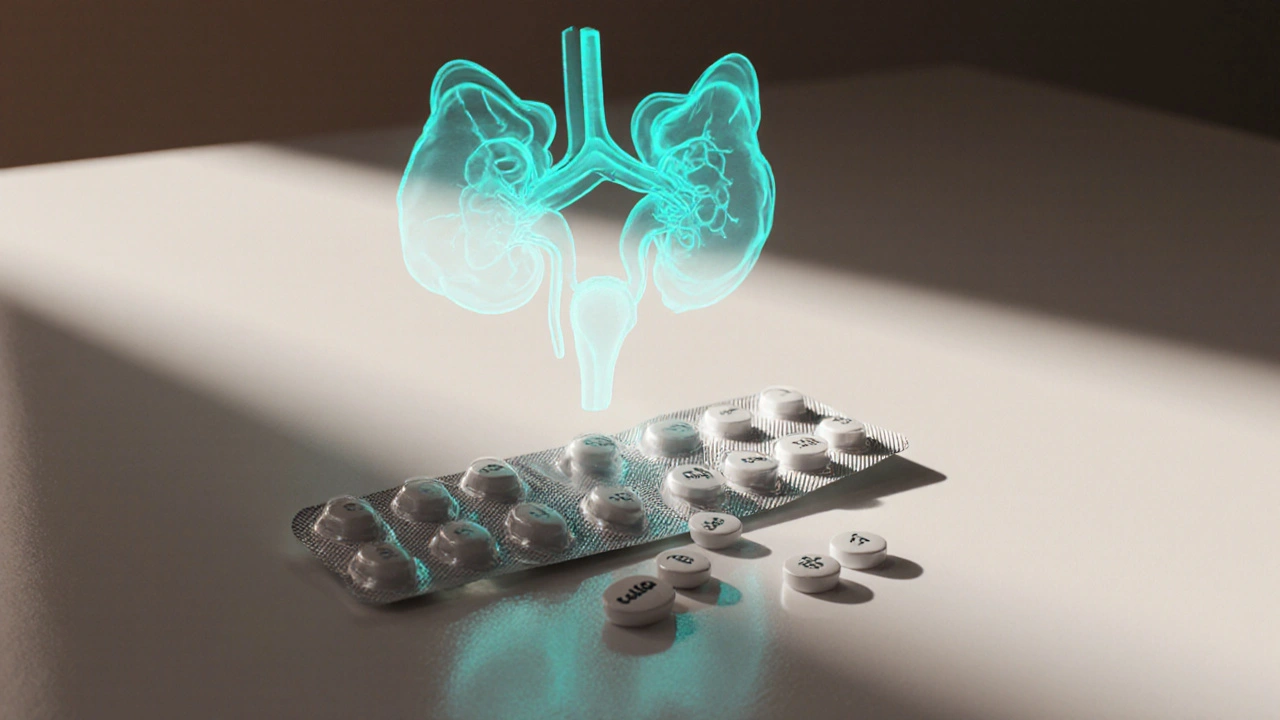Noroxin vs Other Antibiotics: Full Comparison of Fluoroquinolone Alternatives
 Oct, 1 2025
Oct, 1 2025
Noroxin vs Other Antibiotics Comparison Tool
Recommended Antibiotics
| Antibiotic | Primary Use | Side Effects | Cost (10-day course) | Pregnancy Safety |
|---|
When a doctor prescribes a fluoroquinolone, many patients wonder if Noroxin is the right choice or if another drug would work better. This guide breaks down Noroxin’s key traits, lines it up against the most common alternatives, and gives you the facts you need to discuss options with your clinician.
Quick Takeaways
- Noroxin (norfloxacin) is a second‑generation fluoroquinolone mainly used for urinary‑tract infections.
- Its spectrum covers many Gram‑negative bugs but is weaker against Gram‑positive organisms compared with newer fluoroquinolones.
- Cost is generally lower than levofloxacin or moxifloxacin, but side‑effect rates are similar.
- Pregnancy safety is category C; alternatives like amoxicillin are category B.
- Choosing the best drug depends on infection type, resistance patterns, and patient risk factors.
How Noroxin Works
Noroxin’s active ingredient, norfloxacin, belongs to the fluoroquinolone class. It blocks bacterial DNA gyrase and topoisomerase IV, enzymes essential for DNA replication. By halting these enzymes, the drug kills rapidly dividing bacteria rather than merely stopping their growth.
Because it concentrates well in urine, Noroxin became a go‑to option for uncomplicated cystitis and pyelonephritis. Its pharmacokinetic profile includes a half‑life of about 3-4hours, so a typical adult dose is 400mg taken twice daily for 5‑10days.
Common Alternatives to Noroxin
When a clinician considers a fluoroquinolone, the likely substitutes are other agents in the same class or drugs from different families that treat the same infection. Below are the most frequently compared alternatives.
Ciprofloxacin - another second‑generation fluoroquinolone, broader Gram‑negative coverage, often used for prostatitis and gastrointestinal infections.
Levofloxacin - a third‑generation fluoroquinolone with enhanced activity against Gram‑positive organisms and atypicals, common for community‑acquired pneumonia.
Moxifloxacin - fourth‑generation fluoroquinolone, strong Gram‑positive and anaerobic coverage, reserved for severe respiratory infections.
Trimethoprim‑sulfamethoxazole (TMP‑SMX) - a sulfonamide combo, useful for many urinary pathogens, but prone to hypersensitivity in sulfa‑allergic patients.
Amoxicillin - a beta‑lactam with excellent safety, often first‑line for uncomplicated UTIs caused by susceptible E.coli.
Doxycycline - a tetracycline, works for atypical urinary pathogens and offers anti‑inflammatory benefits.
Azithromycin - a macrolide, occasionally used for UTIs caused by intracellular bacteria; its long half‑life allows once‑daily dosing.
Side‑Effect Profile Comparison
Fluoroquinolones share a core set of adverse effects, but the frequency and severity can vary by molecule.
- Gastrointestinal upset (nausea, diarrhea) - 10‑15% across the class.
- Tendonitis or tendon rupture - lowest with norfloxacin, slightly higher with levofloxacin.
- Central nervous system effects (headache, dizziness) - similar rates, but moxifloxacin reports marginally more visual disturbances.
- QT‑interval prolongation - notable with levofloxacin and moxifloxacin, rare with norfloxacin.
- Clostridioides difficile infection - risk rises with any broad‑spectrum fluoroquinolone; the incidence for norfloxacin is about 1.5% in hospital data from 2023.
Non‑fluoroquinolone options like amoxicillin have far fewer serious systemic effects but may trigger allergic reactions in 5‑10% of patients.
Cost Considerations
Price can tip the balance when efficacy is comparable. Generic norfloxacin typically costs $3‑$5 for a 10‑day course in the United States (2025 pricing). Ciprofloxacin sits at $4‑$7, levofloxacin $8‑$12, and moxifloxacin $12‑$20. TMP‑SMX and amoxicillin are usually under $2, while doxycycline and azithromycin range $5‑$9.
Insurance formularies often place Noroxin on a lower tier, making out‑of‑pocket expenses minimal for patients with high‑deductible plans.

Pregnancy & Lactation Safety
Fluoroquinolones are classified as pregnancy category C in the United States, meaning animal studies have shown risk but there are no adequate human studies. Norfloxacin follows this rule, whereas amoxicillin (category B) and azithromycin (category B) are generally considered safer for pregnant patients.
Lactating mothers should avoid fluoroquinolones because the drugs appear in breast milk at low levels; amoxicillin and doxycycline are usually acceptable.
Decision Matrix: When to Pick Noroxin
Use the following checklist to see if Noroxin aligns with your clinical scenario.
- Infection type: uncomplicated lower urinary‑tract infection caused by E.coli or other susceptible Gram‑negative rods.
- Resistance pattern: local antibiogram shows low fluoroquinolone resistance (<10%).
- Cost sensitivity: patient pays out‑of‑pocket and prefers the cheapest effective option.
- Safety profile: patient has no history of tendon disorders, QT‑prolonging meds, or severe renal impairment.
- Pregnancy status: patient is not pregnant or breastfeeding.
If any of these points miss, a different agent-often a beta‑lactam or a narrower‑spectrum sulfonamide-might be a better fit.
Side‑By‑Side Comparison Table
| Antibiotic | Class | Typical Adult Dose | Primary Use | Gram‑Positive Coverage | Pregnancy Category | Approx. 30‑day Cost (USD) |
|---|---|---|---|---|---|---|
| Noroxin | Fluoroquinolone (2nd‑gen) | 400mg PO BID | UTI, prostatitis | Modest | C | 5‑7 |
| Ciprofloxacin | Fluoroquinolone (2nd‑gen) | 500mg PO BID | UTI, GI infections | Low | C | 6‑9 |
| Levofloxacin | Fluoroquinolone (3rd‑gen) | 750mg PO daily | Pneumonia, sinusitis | High | C | 10‑14 |
| Moxifloxacin | Fluoroquinolone (4th‑gen) | 400mg PO daily | Severe respiratory infections | Very high | C | 15‑20 |
| TMP‑SMX | Sulfonamide combo | 800/160mg PO BID | UTI, MRSA skin infections | Moderate | C | 2‑4 |
| Amoxicillin | Beta‑lactam (penicillin) | 500mg PO TID | UTI (E.coli), otitis media | High | B | 1‑2 |
| Doxycycline | Tetracycline | 100mg PO BID | Atypical UTIs, prostatitis | Low | D | 3‑5 |
| Azithromycin | Macrolide | 500mg PO daily (3days) | Atypical respiratory, some UTIs | Moderate | B | 5‑8 |
Practical Tips for Patients
- Take the full course, even if symptoms improve after a couple of days.
- Stay well‑hydrated; this helps the drug clear the urinary tract.
- Report any sudden joint pain, especially in the Achilles tendon, to your doctor right away.
- If you’re on other meds that affect heart rhythm (e.g., certain anti‑arrhythmics), ask whether a fluoroquinolone is safe.
- Store tablets at room temperature away from moisture; discard any that look discolored.
Frequently Asked Questions
Is Noroxin still effective against E.coli in 2025?
Yes, most regional antibiograms from 2023‑2024 still show E.coli susceptibility rates above 85% for norfloxacin, although local resistance can be higher in areas with heavy fluoroquinolone use.
Can I take Noroxin if I have kidney problems?
Mild to moderate renal impairment usually requires dose adjustment to 400mg once daily. Severe impairment (CrCl<30mL/min) often leads clinicians to choose a non‑renally cleared drug like amoxicillin.
Why do some doctors avoid fluoroquinolones for simple UTIs?
Guidelines from the Infectious Diseases Society of America (IDSA) now recommend first‑line agents such as nitrofurantoin or trimethoprim‑sulfamethoxazole for uncomplicated UTIs, reserving fluoroquinolones for resistant cases to limit collateral damage and resistance development.
Is it safe to use Noroxin while I’m pregnant?
Noroxin is classified as pregnancy category C, meaning risk cannot be ruled out. Doctors usually switch to safer options like amoxicillin or cefazolin during pregnancy unless no alternatives work.
How do I know if I’m experiencing a fluoroquinolone‑related tendon injury?
Typical signs include sudden sharp pain, swelling, or a popping sensation near the tendon (often the Achilles). Reduce activity immediately and contact your healthcare provider; they may discontinue the drug and suggest imaging.
Bottom Line
Noroxin remains a cost‑effective choice for specific Gram‑negative urinary infections when resistance is low and safety concerns are minimal. However, newer fluoroquinolones provide broader coverage, and older non‑fluoroquinolones often have better pregnancy safety profiles. Use the side‑by‑side table and the decision checklist to have an informed conversation with your prescriber.

Irene Harty
October 1, 2025 AT 18:00The pharmaceutical lobby subtly steers prescribing habits toward fluoroquinolones, and Noroxin is a convenient pawn in that game. Moreover, regulatory documents often downplay the tendon‑rupture signal, leaving clinicians in the dark. Consequently, patients may unknowingly accept unnecessary risk.
Brooks Gregoria
October 10, 2025 AT 23:10Most clinicians extol fluoroquinolones as miracle drugs, yet the truth is far more nuanced. In reality, the ecological pressure exerted by these agents fuels resistance that undermines future therapy. Accepting this narrative without question betrays a complacent medical culture.
Sumit(Sirin) Vadaviya
October 20, 2025 AT 04:16👍 The cost savings with Noroxin are real, but remember to weigh the tendon‑risk especially if you’re active. 😊
Theo Roussel
October 29, 2025 AT 09:23From a pharmacokinetic perspective, norfloxacin exhibits a renal clearance rate approximating 120 mL/min, resulting in a urinary concentration gradient that surpasses the MIC for susceptible Enterobacteriaceae. This heightened exposure justifies its preferential use in uncomplicated cystitis, yet it does not compensate for its systemic adverse‑effect profile.
Erick Masese
November 7, 2025 AT 14:30In plain terms, Noroxin does the job for simple urinary bugs, but it lacks the flair of newer agents. It’s cheap, it works, and it’s not the most elegant choice.